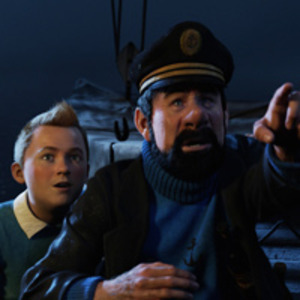Since I’m always eager to see what Steven Spielberg has come up with, I eagerly showed up for an early-morning advance screening of his new action epic, The Adventures of Tintin. Everything about the pre-release hype suggested this one was special: The movie represents Spielberg’s first feature-length experiment with motion-capture storytelling, it’s a collaboration between Spielberg and fellow fantasy-flick titan Peter Jackson, and it’s the first major American presentation of a beloved European character.
And yet, barely 20 minutes into the movie, I was so bored I discreetly left the theater, taking care not to disturb the experiences of other moviegoers whose applause and cheers suggested they found The Adventures of Tintin delightful. I often express unpopular opinions about popular culture, but I’ll be curious to see if anyone joins me on my anti-Tintin island. More specifically, I wonder who will agree with me that the use of motion-capture special effects makes Tintin utterly lifeless, despite Spielberg’s characteristic directorial flair.
To be fair, I’ve got a longstanding gripe against computer animation. Back in the ’90s, when forward-looking filmmakers were first experimenting with CGI in spectaculars like Terminator 2: Judgment Day (1991) and Twister (1996), I got the message: These filmmakers were using new technology to present images that would otherwise be impossible to achieve, thereby expanding the palette available to all filmmakers. Similarly, when 1995’s Toy Story ushered in the era of computer animation, I realized the shift represented an inevitable change; classic hand-drawn animation didn’t provide enough visual data to stimulate kids raised with their eyeballs glued to computer screens. So far, so good.
When CGI became a dominant forces in Hollywood during the 2000s, I raised red flags in articles and columns bemoaning the loss of the human element, and complaining about the way CGI seems to diminish creativity. To prove this last point, just watch any effects-driven movie from the early CGI era, whether it’s X-Men (1999) or Hulk (2003), and watch for the de rigueur scene in which a shapeless blob of CGI mush fills the screen. As soon as the ability to create whiz-bang visuals in post-production collided with the tendency of Hollywood filmmakers to race toward predetermined release dates, we entered an age of CGI effects being the best someone could do in the time allotted, rather than true technological ideals.
Then, thanks to whiplash-inducing hits like Spider-Man (2002), we were introduced to the unpleasant trope of cameras zooming through massive locations with CGI effects bridging various real and virtual sets into more or less seamless wholes. The problem with these types of images is that by defying basic laws of physics, the shots accentuate the fakery of onscreen illusions, even though the traditional goal of special effects is to create fantastic images that viewers can’t differentiate from reality. Oddly, CGI made movies seem more artificial than ever.
But CGI was just an appetizer for the main course: motion-capture performance.
To date, only a handful of movies have been made with this pricey technology, which involves filming live actors and then creating digital characters around the real actors’ performances. The most famous motion-capture character thus far is Gollum (played by Andy Serkis), the creepy-crawly critter who craves the One Ring to Rule Them All in Peter Jackson’s Lord of the Rings trilogy (2001-2003). A perfect example of motion-capture technology used the way it should be used, Gollum is a being that does not exist in nature, given a kind of flesh-and-blood life by Serkis’ performance. And while it’s true the Gollum effects in the first Lord of the Rings movie have already started losing their power to impress, such degradation is unavoidable as technology become more sophisticated; even the once-groundbreaking special effects in Star Wars (1977) seem relatively primitive by today’s standards.
The trick with Gollum, and with more recent motion-capture characters like Caesar the revolutionary chimpanzee in this summer’s Rise of the Planet of the Apes, is that they’re integrated into live-action environments. Characters like Caesar and Gollum are therefore like any other good special effect, used only when needed to help tell a story that’s otherwise grounded in some recognizable version of reality.
True motion-capture movies, like The Adventures of Tintin, are a different story, because these pictures present wall-to-wall digital imagery. Director Robert Zemeckis is the pioneer in this particular field, having made The Polar Express (2004), Beowulf (2007), and A Christmas Carol (2009). James Cameron upped the creative ante with his megahit Avatar (2009), most of which featured motion-capture characters in digital environments. Many found these pictures awe-inspiring. For me, however, they all feel like cartoons without the charm and live-action without the realism. They were the worst of both worlds. And sure enough, my disdain for the motion-capture form was exactly what drove me from the theater showing Tintin.
I was a teenager during the Spielberg-dominated ’80s, and I adore Raiders of the Lost Ark, so I appreciate the mile-a-minute style of his escapist adventures. Furthermore, I recognized the trace elements of Raiders in Tintin, from the sweeping revelations of impossible obstacles to the vividly realized visual elements, like Tintin’s faithful canine pal, Snowy. I believe I understood what reaction the movie was supposed to elicit.
Yet I simply could not wrap my brain around the presentation. Every single image seemed like it would be more effective as either pure animation or pure live-action. Sly visual flourishes like the way the villain wields his cane would work in a cartoon, and deeper moments like the way fright plays across Tintin’s face would have more impact in live-action. Unlike Avatar, which takes place in an alien environment and features inhuman creatures, Tintin features images that could be created on a soundstage.
So what’s the point of using motion capture?
The motion capture in Tintin struck me as an unnecessary veil of technological eye candy separating the audience from the story. Nothing in Tintin felt photo-realistic, and yet nothing in the part of the movie I saw was so fantastic it could only be created using motion-capture. For instance, some of the movie’s characters are designed like cartoon creatures, with comically oversized facial features and such, and yet Tintin himself is a mostly realistic-looking human boy. If Spielberg wanted a stylized effect to some of the characters, couldn’t he have simply used makeup?
Throughout his career, Spielberg has used special effects masterfully, whether he’s employing on-set physical effects to suggest the presence of a giant killer shark in Jaws or utilizing CGI to replace the World Trade Center in the New York skyline for the conclusion of Munich (2005). But for me, the motion capture in Tintin seems as unhelpful as the fake-looking Neverland sets in one of Spielberg’s few misfires, Hook (1991). To his credit, when Spielberg commits to something, he commits wholeheartedly, but I worry what will happen now that he’s put his imprimatur on a technological advance the benefits of which are not yet evident to me.
If Spielberg can’t make motion capture magical, I wonder if anyone can.





